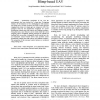Free Online Productivity Tools
i2Speak
i2Symbol
i2OCR
iTex2Img
iWeb2Print
iWeb2Shot
i2Type
iPdf2Split
iPdf2Merge
i2Bopomofo
i2Arabic
i2Style
i2Image
i2PDF
iLatex2Rtf
Sci2ools
121
click to vote
ICRA
2005
IEEE
2005
IEEE
A Biologically Based Flight Control System for a Blimp-based UAV
- Autonomous navigation in 2D and 3D environments has been studied for a long time. Navigating within a 3D environment is very challenging for both animals and robots and a variety of sensors are used to solve this task ranging from vision or a simple gyro or compass to GPS. The principal tasks for 3D autonomous navigation are course stabilization, altitude and drift control, and collision avoidance. Using this basis, some features can be easily added like aerial mapping, object recognition, homing strategies or takeoff and landing. Here we present a biologically based control layer for an Unmanned Aerial Vehicle (UAV) that provides course stabilization, altitude and drift control, and collision avoidance. The properties of this neuronal control system are evaluated using a flying robot.
| Added | 25 Jun 2010 |
| Updated | 25 Jun 2010 |
| Type | Conference |
| Year | 2005 |
| Where | ICRA |
| Authors | Sergi Bermúdez i Badia, Pawel Pyk, Paul F. M. J. Verschure |
Comments (0)

